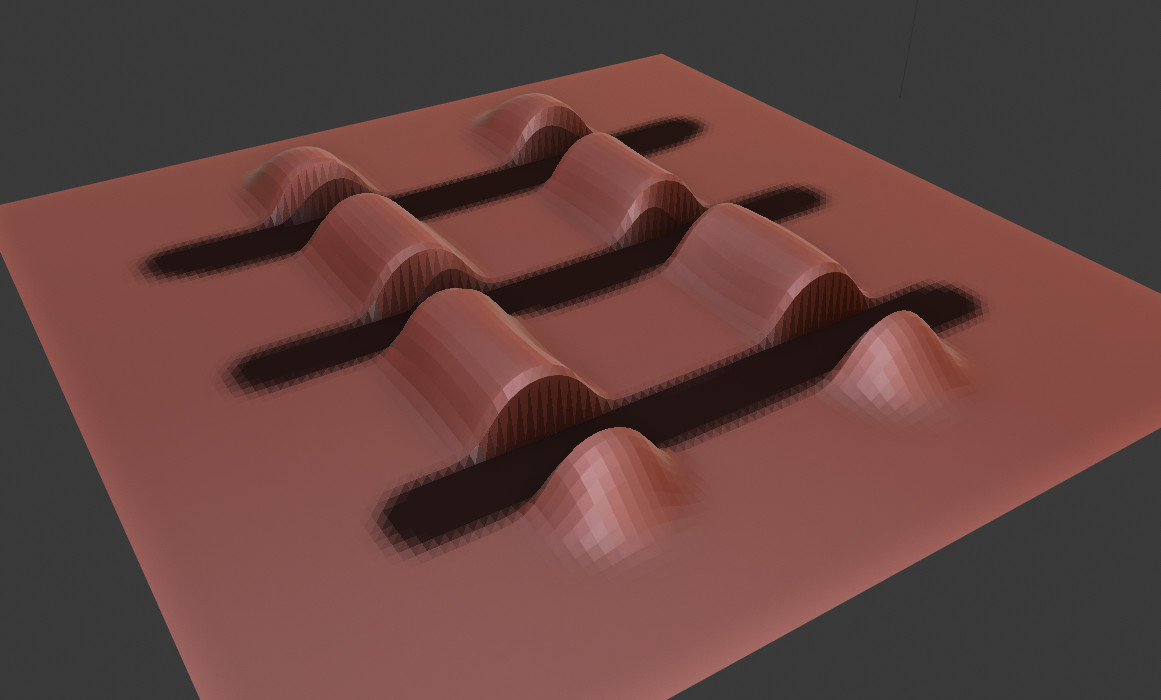遮罩
遮罩用于控制网格的哪些区域会受到雕刻的影响。

被遮罩的部分显示为黑色。
笔刷
To edit the mask, select the Mask Brush from the Brush panel.
编辑
参考
- 模式
雕刻模式
- 菜单
可以在整个模型中编辑遮罩。使用 A 打开饼菜单以选择不同的操作。
反转遮罩
参考
- 模式
雕刻模式
- 菜单
- 快捷键
Ctrl-I
反转现有的遮罩。
填充遮罩
参考
- 模式
雕刻模式
- 菜单
使用为1的数值来填充整个遮罩。
清除遮罩
参考
- 模式
雕刻模式
- 菜单
- 快捷键
Alt-M
Fills the mask with a value of 0. To completely remove the mask data, see Clear Sculpt-Mask Data.
框选遮罩
参考
- 模式
雕刻模式
- 菜单
- 快捷键
B
其工作方式类似 框选 工具,它可以创建一个矩形的遮罩区域。按住 Shift 来清除选择区域内的遮罩。
套索遮罩
参考
- 模式
雕刻模式
- 菜单
- 快捷键
Shift-Ctrl-LMB
可用于创建自由形式的遮罩,与 套索 选择类似。
Tip
要使用 套索遮罩 工具清除区域的遮罩,首先反转遮罩,应用 套索遮罩,然后再将遮罩反转回来。
遮罩滤镜
参考
- 模式
雕刻模式
- 菜单
遮罩滤镜是应用于整个绘制遮罩的操作。
- 类型
- 平滑/锐化遮罩
Changes the crispness of the mask edge.
- 生长/收缩遮罩
Changes the size of the mask.
- 提高/降低对比度
Changes the contrast of the mask.
- 迭代
The number of times that the filter is going to be applied.
- 自动迭代次数
Use an automatic number of iterations based on the number of vertices of the sculpt.
按拓扑展开遮罩
参考
- 模式
雕刻模式
- 菜单
- 快捷键
Shift-A
以均匀的方式从活动顶点向外辐射遮罩。
Note
This operator is meant to be used interactively through the shortcut.
快捷键
- 反转
F Flips between expanding a positive mask (value of one) or a negative mask (value of zero). In the case of face sets, this option flips between including areas inside the masked area or areas outside the masked area.
- Toggle Preserve State
E Accumulates the new mask on top of the previous one instead of replacing it. For Face Sets, this creates Face Sets boundaries instead of replacing the existing Face Set.
- Toggle Gradient
G Enables linear gradient, creates a linear gradient of values from the origin to the current active vertex.
- Geodesic Recursive Step
R Generate a new Geodesic falloff from the boundary of the enabled vertices of the current falloff.
- Topology Recursive Step
Alt-R Generate a new topology flood fill falloff from the boundary of the enabled vertices of the current falloff.
- 移动原点
Spacebar Moves the initial vertex used for calculating the falloff.
- Geodesic Falloff
1 Uses a falloff based on the Geodesic distances from the edge boundary to the active vertex.
- Topology Falloff
2 Uses a falloff based on a flood fill using edges.
- Diagonals Falloff
3 Uses a falloff based on a flood fill using polygon diagonals and edges.
- Spherical Falloff
4 Uses a falloff based on the Euclidean distances from the edge boundary to the active vertex.
- Snap Expanded to Face Sets
Ctrl Isolates the expanded region to the boundary of the face set under the cursor.
- Loop Count Increase
W Increase the number of loops or iterations the operator is run; using four loops will split the mask into four parts.
- Loop Count Decrease
Q Decrease the number of loops or iterations the operator is run; using four loops will split the mask into four parts.
- Toggle Brush Gradient
B Similar to linear gradient but uses the current brush Falloff to define the shape of the falloff.
- Texture Distortion Increase
Y Increases the falloff distance when using a texture to distort the mask shape.
- Texture Distortion Decrease
T Decreases the falloff distance when using a texture to distort the mask shape.
用法
纹理
Textures can be used to affect the "strength" of the mask. This feature can be combined with loops and recursion to create really unique looking masks. To enable textures, you first need to create/select a texture to use, this is done by in the Properties editor's Texture Properties. Next select the texture in the Texture Brush Settings, while there make sure to enable 3D Mapping. Now, you can use Y and T to increase or decrease the affect the texture has on the edge of the mask.
按法向展开遮罩
参考
- 模式
雕刻模式
- 菜单
- 快捷键
Shift-Alt-A
Creates a mask radiating outwards from the active vertex while following the curvature of the mesh. This operator uses the same internal operator as 按拓扑展开遮罩 meaning all the shortcuts and functionality works the same as that tool.
Note
This operator is meant to be used interactively through the shortcut.
遮罩提取
参考
- 模式
雕刻模式
- 菜单
从被遮蔽的几何体创建副本网格物体。
- 阈值
最小遮罩值,用以考虑从原始网格中提取面的顶点有效。
- 添加边界循环
Creates and extra boundary loop on the edges of the geometry, making it ready for adding a Subdivision Surface modifier later.
- 平滑迭代
应用于提取网格的平滑迭代次数。
- 投影至雕刻
将提取的网格投影到原始雕刻物体中。
- 提取为实心
向新创建的网格物体添加 实体化修改器。
遮罩切片
参考
- 模式
雕刻模式
- 菜单
从网格中删除遮罩顶点。
- 阈值
最小遮罩值,用以考虑从原始网格中提取面的顶点有效。
- 填充洞面
使用可能由 遮罩切片 操作产生的几何体填充凹孔。
- 切片到新物体
从被遮蔽的几何体创建新的物体。
污迹遮罩
参考
- 模式
雕刻模式
- 菜单
基于几何型腔和尖锐度生成遮罩。
随机遮罩
参考
- 模式
雕刻模式
- 菜单
Generates a mask with random values for the entire object based on different mesh data.
- 逐顶点
Assigns a random mask value for each vertex.
- 逐面组
Assigns a random mask value for each Face Set.
- Per Loose Mask
Assigns a random mask value for each disjoint part of the mesh.
显示设置
参考
- 模式
雕刻模式
- 弹出框
The mask display can be toggled as a viewport overlay. In the overlay popover, the opacity of the mask overlay can be adjusted to make it more or less visible on the mesh.
清除雕刻遮罩数据
参考
- 模式
物体/编辑模式
- 菜单
Completely frees the mask data layer from the mesh. While not a huge benefit, this can speed-up sculpting if the mask is no longer being used.